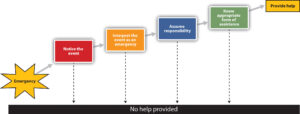What causes people to help those in need? Whether it is hearing gunshots, seeing an injured or ill individual on the streets, or simply extending a helping hand, what are the factors which dictate whether or not others will offer help? Researchers John Darley and Bibb Latane (1968) asked the same questions and created the bystander intervention model based on their findings.
When Kitty Genovese was stabbed to death in the middle of a New York street with no law enforcement responding, it triggered research.
Why do bystanders not help those in need? According to Darley and Latane (1968), people responded to this question by saying they do not want to get involved, are fearful of physical harm, experience public embarrassment, or that someone else will do something to help the situation.

When there are other individuals around, there is a diffusion of responsibility. People assume that someone else has called 911 or assisted in some manner. When there is only one individual or a small group of people, they are able to discuss the situation to take action and help those in need. The responsibility to help is placed on the one individual or small group and they are more likely to take action.
The Study
In order to test and observe these hypotheses, Darley and Latane (1968) created an experimental study to observe how individuals respond in various situations.
Participants were placed in a “discussion group” about college life experiences which took place over an intercom system. During the discussion, another student in the group had a seizure, which was expressed through a recorded script. The researchers measured how quickly students responded to the situation by telling the experimenter. They tracked the number people through to be in the group and how that affected the response time.
The Results
The results of the study confirmed the above hypotheses in that 85% of those who thought they were the only ones who knew about the situation reported the seizure before the recording had stopped. However, 31% of those who thought someone else in the group would report still reported. When individuals were in a two-person study group, all of the participants reported the situation. When in the six-person discussion group, 62% of the participants reported the emergency.
Implications
These findings are consistent with the Kitty Genovese stabbing. When there are more people or a perceived greater number of people, one individual is less likely to assist as quickly or if at all compared to one individual approaching the situation.
Darley, J.M., & Latane, B. (1968). Bystander intervention in emergencies: Diffusion of responsibility. Journal of Personality and Social Psychology, 8, 377-383.